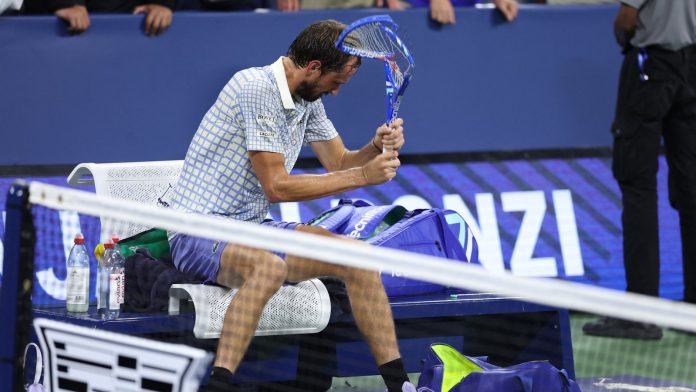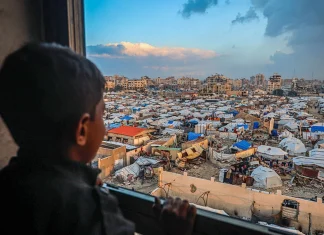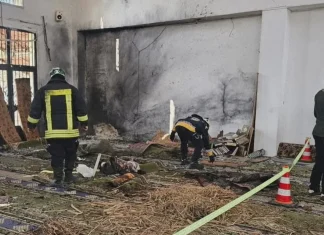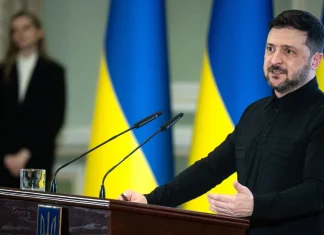Chaos and Drama Unfold at the US Open: A Day Where Tennis’s Grace Gave Way to Unforgettable Turmoil
There are moments in sports when the unexpected ripples through the air, stealing the breath of thousands and compelling everyone watching to lean in a little closer. The 2025 US Open threw such a curveball on Sunday—a first-round match that promised tension but erupted into pandemonium, forever etching itself into the tournament’s lore.
Daniil Medvedev, a former champion known for his cool analytical play, found himself at the center of an extraordinary on-court meltdown that no one saw coming. The stage was set: Medvedev squaring off against the French underdog Benjamin Bonzi, a player whose resilience would be tested in ways he hadn’t imagined. And yet, it wasn’t the rally or the racket that turned heads—it was a rogue photographer strolling onto the court at the most critical moment: match point.
When Focus Fractured: An Interrupted Serve and a Furious Outburst
Picture this: Bonzi serving at 5-4 in the fourth set, just one point away from knocking out the elite Russian star. The atmosphere in Louis Armstrong Stadium was electric, every spectator holding their collective breath. And then, suddenly, an intruder—a photographer—steps onto the court surface, breaking the sacred concentration athletes hold in these high-stakes moments.
Chair umpire Greg Allensworth’s decision—to have Bonzi redo his serve after the disruption—ignited an explosive reaction from Medvedev. In a manner rarely seen on a tennis court, he confronted the umpire with sharp words, a whirlwind of frustration and disbelief.
“Are you a man? Are you a man? Why are you shaking?” Medvedev barked at Allensworth, storming back and forth as the tension snapped into public view like a taut wire. “He wants to go home, guys, he doesn’t like it here. He gets paid by the match, not by the hour,” he seethed at the photographers and officials alike.
As if the drama wasn’t thick enough, Medvedev’s fiery mood was further stoked by references to past controversies, shouting, “What did Reilly Opelka say?”—a dig at the umpire’s prior encounters with players, highlighting a simmering tension that bubbled over on this day.
The Crowd Roars, the Photographer Expelled, but the Damage is Done
The interruption had the crowd roaring with boos and whistles, refusing to give Bonzi the quiet he needed to serve. For six long minutes, the match was suspended in a charged standoff. Amidst this chaos, the United States Tennis Association (USTA) acted swiftly, escorting the photographer off the court and revoking his credentials, a rare but necessary enforcement to preserve the sanctity of the sport.
Meanwhile, Benjamin Bonzi, the Frenchman who might have once been overshadowed by tennis titans, was battling not just his opponent but the very environment itself—including his own moments of fury when he threatened to quit, loudly calling for Medvedev’s disqualification.
The match, a rollercoaster in every sense, finally concluded with Bonzi edging through with a 6-3 7-5 6-7(5) 0-6 6-4 victory, toppling Medvedev and delivering one of the most dramatic finishes Flushing Meadows has witnessed in years.
Meanwhile at the US Open: Age, Endurance and Emerging American Hopes
While the Medvedev-Bonzi saga gripped the spotlight, other narratives quietly unfurled on adjacent courts, signaling shifts in tennis’s global landscape.
Djokovic’s Grit and the Struggles of a Tennis Legend
Novak Djokovic, now 38 and navigating the physical toll of a long and grueling career, struggled against rising American player Learner Tien. The scoreline—6-1 7-6(3) 6-2—appeared straightforward but concealed the intense physical battle underneath. The second set’s tie-break alone stretched 82 minutes, where Djokovic’s endurance was visibly stretched to its limits.
“I have to be honest, the physical side is a concern now,” Djokovic admitted post-match, his black shirt drenched in sweat, pain evident as he navigated blisters on his foot with medical treatment.
Yet, experience prevailed as Djokovic secured his victory, setting up a second-round clash with another American, Zachary Svajda. It’s a poignant scene: a legend slowing but fighting, trying to carve out every inch of floor he can in a sport where youth is relentless.
American Hope: Fritz and Shelton Leading the Charge
Other American men, thirsting to end a 22-year drought for the US Open title on home soil, started their campaigns on solid footing. Taylor Fritz, who last year rekindled American hopes by reaching the final, showcased his powerful serve—delivering 11 aces—as he dismantled wildcard Emilio Nava 7-5 6-2 6-3.
Taylor isn’t just playing for himself. He’s following in the footsteps of American women who have dominated recently, like Madison Keys and rising star Coco Gauff, both of whom claimed Grand Slam titles in 2025. Since Andy Roddick’s 2003 victory, American women’s success at the majors has wildly eclipsed that of their male counterparts, accumulating 25 Grand Slam titles collectively.
Ben Shelton also advanced, adding to the sense that a new wave of American talent is ready to challenge tennis’s traditional powerhouses. The yearning for a homegrown men’s champion has never felt more palpable.
Beyond the Lines: What Does This Chaotic Day Mean for Tennis and Sport at Large?
In an era when precision, control, and sportsmanship are lauded as pillars of tennis—Sunday’s US Open chaos raises pointed questions about the intersection of human error, professionalism, and the athlete’s mental space.
How tolerant should an elite sport be to distractions? When should officials intervene—and how aggressively? And, crucially, how do players manage the immense pressure when even external disruptions threaten to derail years of preparation?
Medvedev’s meltdown was raw, brash, and sometimes disheartening, yet it also unveiled the frailty beneath the battle-hardened exterior of top athletes. It reminded everyone watching that behind every polished player exists raw humanity, subject to breaking points.
Meanwhile, Bonzi’s unexpected victory, punctuated by moments when he nearly walked away, mirrors the mercurial journey many athletes face—balancing ambition, frustration, and resilience.
Consider this: in a world increasingly obsessed with flawless social media portrayals and tightly scripted narratives, moments like these—frayed tempers, unpredictable interruptions, the grit to keep playing—remind us why we love sports. It is chaos and order, failure and triumph, in real time, unfolding before us.
As you reflect on this episode, ask yourself: How would you react under such intense scrutiny and interruption? What does sportsmanship look like in the 21st century when outside forces constantly intrude on the arena? The US Open’s drama is more than a tennis story—it’s a mirror to life’s unpredictability and the resilience we all strive for.
Looking Ahead: The Road Forward at Flushing Meadows
As the tournament progresses, eyes will no doubt follow the veteran Djokovic’s quest to defy time, the rising American hopefuls eager to rewrite history, and the lingering questions about how tennis—and all professional sports—navigate the fine line between spectacle and chaos.
One thing is certain: if Sunday’s chaos was any indication, the 2025 US Open will be remembered not only for the champions crowned but the raw, human drama that makes tennis more than just a game—but a vivid story of triumph, turmoil, and tenacity.










